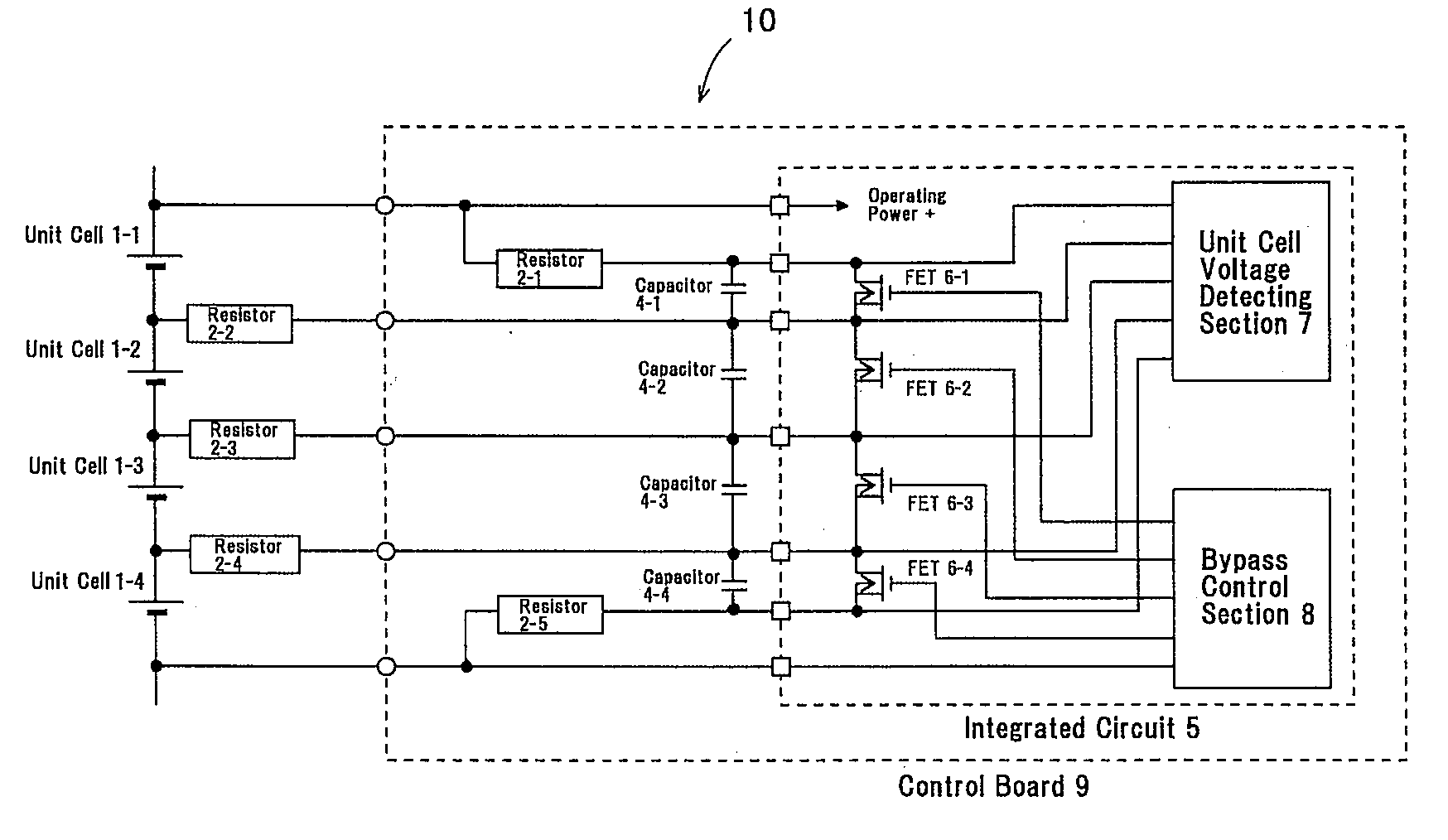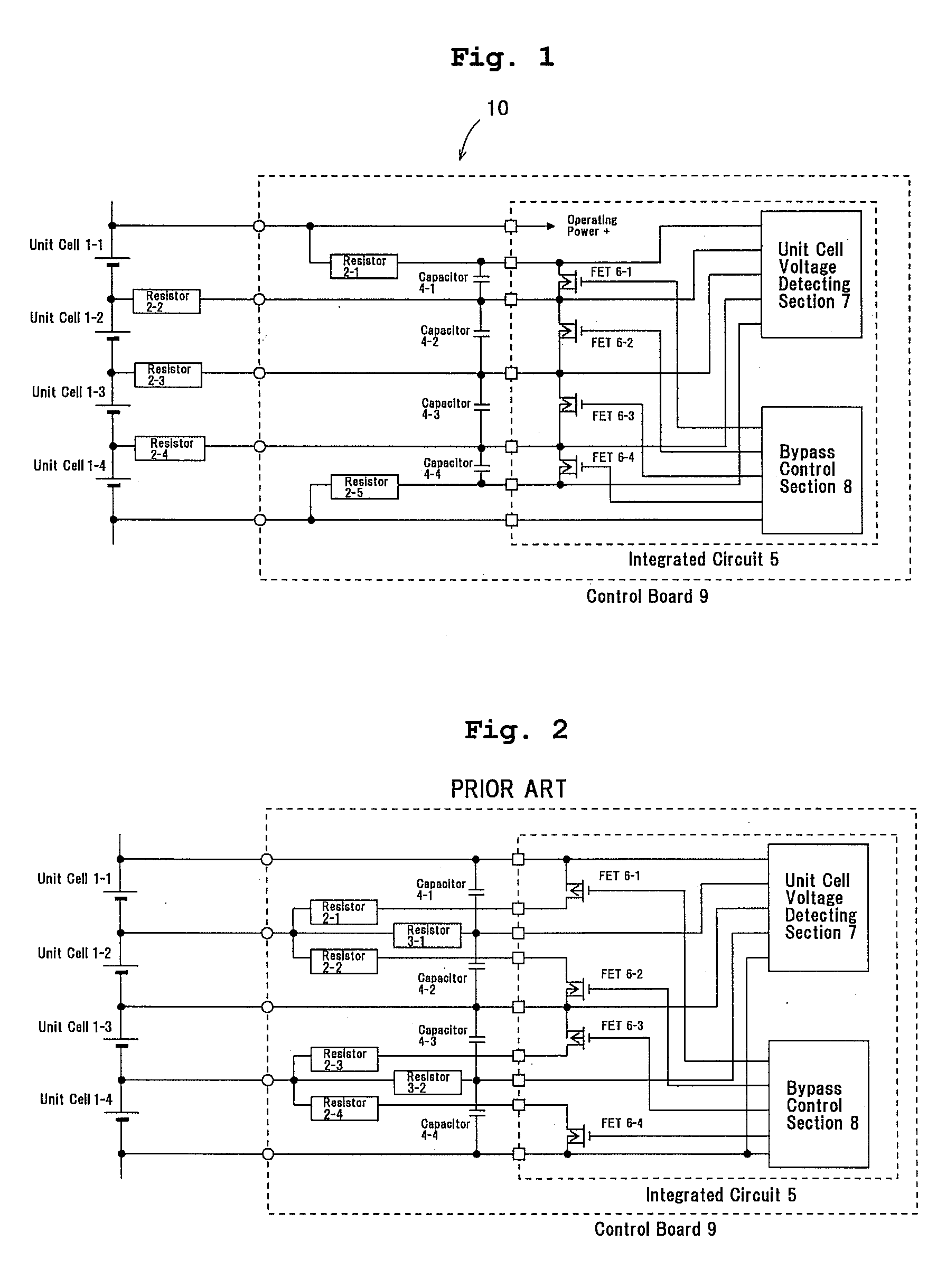[0006]In view of the above circumstances, an object of the present invention is to provide a cell controller which is capable of ensuring high safety even when a short occurs among voltage detecting lines without causing increased costs.
[0008]In the present invention, the resistors for SOC adjustment are inserted in series to the voltage detecting lines and the positive
electrode and negative
electrode of each of the unit cells are connected through each of the voltage detecting lines to the
control circuit including the unit
cell voltage detecting section, the switching elements or a like. Accordingly, currents flowing due to a short among the voltage detecting lines are limited and safety of the cell controller can be enhanced and, further, the resistors provided originally for SOC adjustment of each of unit cells are used also for a safety measure, thus preventing an increase in costs. In particular, in a configuration employed in the present invention, that the unit cell voltage detecting section, switching elements, and control section out of the SOC control section are housed in an
integrated circuit, voltage detecting terminals used for connection of the unit cells to the unit cell voltage detecting section and conducting terminals used for connection of a drain and / or source of the switching element including FETs to the resistors for SOC adjustment are used commonly to reduce the number of the terminals, thereby enabling the reduction of costs for the
integrated circuit.
[0009]In the embodiment of the present invention, in a case that, when a unit cell voltage is detected by the unit cell voltage detecting section, the
control unit lets each of switching elements corresponding to each of unit cells whose voltage is to be detected and to each of unit cells disposed at higher and lower sides of the each of the unit cells whose voltage is to be detected enter an OFF state, no bypass currents flow at the time of detecting a voltage of each of the unit cells and no
voltage drop caused by the resistors of SOC adjustment occurs, which enables the exact measurement of each of the unit cells. Further, when a configuration is employed that the
control unit exercises control so that the unit cells whose voltage are to be detected are switched at every predetermined time, the bypass discharging by the resistors for SOC adjustment is stopped only at a time of detecting a voltage of each of the unit cells by using a
simple circuit, for example, an oscillating circuit to detect a voltage of each of the unit cells. Furthermore, when a configuration is employed that the control section exercises control so that SOC adjustment is not performed simultaneously among unit cells adjacently disposed at higher and lower sides of each of unit cells constituting the battery group, normal conduction of the bypass current can be achieved. That is, if bypass discharging of unit cells adjacently disposed is performed at the same time, since no currents flow through the resistors for SOC adjustment connected to the voltage detecting lines commonly connected and no
voltage drop occurs, resulting in the flow of bypass currents being larger than assumed, thus making it difficult to perform normal SOC adjustment of unit cells. In this configuration, in order to simplify the control, the control section may exercise control so that the unit cells to be adjusted are switched, at every predetermined time, between odd-numbered unit cells and even-numbered unit cells enumerated from a highest or lowest cell constituting the battery group. As described above, it is preferable that the unit cell voltage detecting section, switching elements, and control section making up the SOC adjusting section are housed in an
integrated circuit. In a configuration of the present invention, all or part of the resistors is preferably located near the unit cells making up the battery group. The resistors except the resistors connected to a positive electrode of a highest unit cell and a negative electrode of a lowest unit cell out of the unit cells making up the battery group may be disposed near the unit cells constituting the battery group. Moreover, it is preferable that the cell controller further comprises capacitors connected in parallel through the resistors to each of unit cells making up the battery group, and the resistors and the capacitors function as a RC filter. The cell controller can suitably control a battery group operating as a power source for a
hybrid electric vehicle.
[0010]According to the present invention, effects can be obtained that since the resistors for SOC adjustment are inserted in series into the voltage detecting lines and the positive electrode and negative electrode of each of the unit cells are connected through each of the voltage detecting lines to the
control circuit including the unit cell voltage detecting section, the switching elements or a like, and since currents flowing due to a short among the voltage detecting lines are limited and safety of the cell controller can be enhanced, the resistors provided originally for SOC adjustment of each of unit cells are used also as a safety measure, thus preventing an increase in costs.
 Login to View More
Login to View More  Login to View More
Login to View More 


